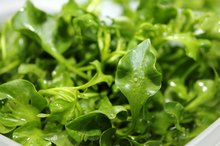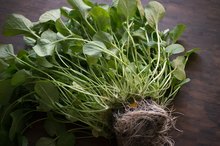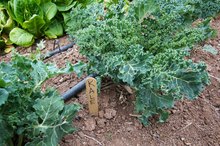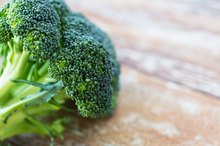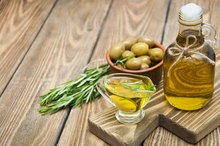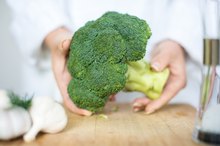Does Blanching Kale Reduce Its Nutrition?
Kale is a dark leafy green, a member of the cabbage family, and packed full of nutrients and dietary fiber. While kale can be chopped or shredded and eaten raw, it is also more commonly eaten cooked. Cooking vegetables in water, as in the case of blanching, can mean that some of the vitamins are leached out during the cooking process.
About Blanching
Blanching requires cooking the leaves in steam or boiling water for a short period of time. Afterwards, you need to dunk the cooked leaves in iced water to stop the process. This cooking method produces brightly colored vegetables and a crisp-tender texture. In some cases, salt is added to the cooking liquid to provide seasoning.
- Blanching requires cooking the leaves in steam or boiling water for a short period of time.
- In some cases, salt is added to the cooking liquid to provide seasoning.
Water-Soluble Vitamins
How to Cook Watercress
Learn More
Water-soluble vitamins leach out from foods during water cooking processes. Water soluble vitamins include members of the vitamin B complexes and vitamin C. Because of the exposure to water at high temperatures, blanching easily destroys vitamins C and B, as they are very sensitive. A 2008 issue of “Natural Product Radiance” included a study that found that longer the cooking times and higher cooking temperatures led to progressively lower levels of available vitamin C in leafy green vegetables 1.
Kale Nutritional Profile
Kale is rich in a variety of nutrients and is naturally low in calories. A 1-cup serving of raw, chopped kale has only 33 calories, almost 3 grams of protein, 0.6 grams of total fat and almost 6 grams of dietary fiber. It is also a good source of potassium and calcium, with 329 and 100 milligrams, respectively, per serving. A serving also has 80 milligrams of vitamin C, 94 milligrams of folate and is a good source of thiamin, riboflavin, niacin and vitamin B-6. It also has a little over 1 milligram of vitamin E. However, the B vitamins, vitamin C and vitamin E will be mostly lost during the blanching process.
- Kale is rich in a variety of nutrients and is naturally low in calories.
- It also has a little over 1 milligram of vitamin E. However, the B vitamins, vitamin C and vitamin E will be mostly lost during the blanching process.
Getting the Most Nutritionally
How to Keep and Store Watercress
Learn More
As a nutritionally dense vegetable, kale has a number of dietary benefits. To reduce the number of lost vitamins, keep the blanching process quick, with your water temperature as close to just boiling as possible. While it may take more time, consider steaming kale rather than placing it in boiling water to blanch it, to reduce the amount of vitamins lost. You can also eat kale raw, rubbing the chopped leaves with oil to make the leaves more tender 5.
- As a nutritionally dense vegetable, kale has a number of dietary benefits.
- While it may take more time, consider steaming kale rather than placing it in boiling water to blanch it, to reduce the amount of vitamins lost.
Related Articles
References
- The Kitchn: How To Blanch Vegetables
- Better Health Channel: Food Processing and Nutrition
- U.S. Department of Agriculture: Kale, Raw
- The Kitchn: Five Ways To Eat Kale
- Kale, raw. USDA FoodData Central. Updated April 1, 2019
- Tapsell LC, Batterham MJ, Thorne RL, O'Shea JE, Grafenauer SJ, Probst YC. Weight loss effects from vegetable intake: a 12-month randomised controlled trial. Eur J Clin Nutr. 2014;68(7):778–785. doi:10.1038/ejcn.2014.39
- Blekkenhorst LC, Sim M, Bondonno CP, et al. Cardiovascular Health Benefits of Specific Vegetable Types: A Narrative Review. Nutrients. 2018;10(5). doi:10.3390/nu10050595
- Lin T, Zirpoli GR, McCann SE, Moysich KB, Ambrosone CB, Tang L. Trends in cruciferous vegetable consumption and associations with breast cancer risk: A case-control study. Curr Dev Nutr. 2017;1(8):e000448. Published 2017 Jul 18. doi:10.3945/cdn.117.000448
- Vitamin K. National Institutes of Health. February 2020.
- Fusaro M, Mereu MC, Aghi A, Iervasi G, Gallieni M. Vitamin K and bone. Clin Cases Miner Bone Metab. 2017;14(2):200–206. doi:10.11138/ccmbm/2017.14.1.200
- Vitamin C. Fact Sheet for Professionals. National Institutes of Health Office of Dietary Supplements. Updated February 27, 2020
- Antioxidants: In Depth. National Institutes of Health. National Center for Complementary and Integrative Health. Updated November 2013
- Kale. Natural Medicines Database. The Therapeutic Research Center. Updated 4/13/2020
- Fabbri ADT, Crosby GA. A review of the impact of preparation and cooking on the nutritional quality of vegetables and legumes. International Journal of Gastronomy and Food Science. 2016;(3):2-11. doi:10.1016/j.ijgfs.2015.11.001
- Labensky, SR, Hause, AM. On Cooking: A textbook of Culinary Fundamentals. 3rd ed. Upper Sadle River, NJ: Prentice Hall, 2003: 618.
Writer Bio
Jessica Lewis has published professionally since 2005 and is a registered dietitian and nutritionist. Her work is regularly found in the "National Post" and "Oxygen Magazine." She holds degrees from the University of Guelph and McMaster University. A marathon runner and yoga enthusiast, she is also interested in alternative medicine.
